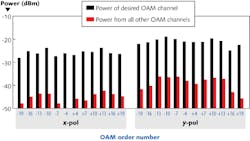Free-Space Communications: 100 Tbit/s link uses orbital-angular-momentum multiplexing
A free-space link developed by researchers at the University of Southern California (USC; Los Angeles, CA), the Jet Propulsion Lab (JPL; Pasadena, CA), the University of Glasgow (Glasgow, Scotland), and Tel Aviv University (Tel Aviv, Israel) achieves its 100 Tbit/s data-transmission rate not only by wavelength-division multiplexing (WDM) and polarization-division multiplexing (PDM), but by adding in orbital-angularmomentum (OAM) multiplexing as well.1
A laser beam that carries OAM has a helical phase, with the order of helicity (the vortex “charge”) corresponding to the amount of angular momentum each photon carries (in multiples of the reduced Planck’s constant ℏ). In an OAM-multiplexed system, multiple coincident beams, each with a differing vortex charge, can carry independent streams of data, which are then demultiplexed and read separately.
Three types of multiplexing
The WDM portion of the experimental setup consists of 42 wavelengths in the 1536.34 to 1568.5 nm spectral range (100 GHz apart), with each beam carrying 100 Gbit/s of quadrature phase-shift keyed (QPSK) data. The researchers decorrelate the data of neighboring WDM channels by separating every other channel with an optical interleaver, delaying the signal by about 5 ns before recombining all signals.
To create OAM, each WDM data channel is split into two copies, which are decorrelated from each other by running one of the beams through a 100-m-long single-mode fiber. Using a combination of polarizers and reflective spatial light modulators (SLMs), varying amounts of vortex charge (+4, +7, +10, +13, +16, and +19) are added to six different beams; these beams are split in two and one copy is reflected to create six beams with inverse charges. All 12 beams are then recombined.
To add PDM, the 12 beams are split again and one of them polarization rotated by 90° and further decorrelated (delayed) before recombining. The result is 24 channels for each of the 42 wavelengths.
For the test, the free-space transmission distance was set to 1 m. A polarizer, half-wave plate, and SLM with an inverse spiral phase pattern does the polarization and OAM demultiplexing, producing a Gaussian beam that is coupled into a single-mode fiber and a tunable filter, which performs the wavelength demultiplexing.
The researchers measured the crosstalk of the OAM multiplexing and demultiplexing on a single wavelength, finding that the crosstalk ranged from -15.9 to -25.2 dB over the 24 channels (see figure). Crosstalk as a function of wavelength was also measured, showing almost no dependence of crosstalk on wavelength.
Using the demultiplexed channel with the highest crosstalk, the researchers then measured bit-error rate (BER) as a function of optical signal-to-noise ratio under varying conditions (all channels on, producing maximum crosstalk; only one group of OAM beams on, eliminating OAM crosstalk; and other relevant combinations). For a BER of 3.8 × 10-3, WDM and OAM produced power penalties of 0.3 and 1.7 dB, respectively; the OAM figure could be reduced by using a better SLM, say the researchers.
The researchers also propose replacing the bulk SLMs and beamsplitters in their setup with integrated optical devices, along with replacing the tunable filter with an array-waveguide grating, which would enable simultaneous wavelength demultiplexing. Longer-distance free-space transmission could require adaptive optics to reduce the effects of atmospheric turbulence, as well as large receiving optics due to the fact that beams with higher vortex charges have higher divergence.
REFERENCE
1. H. Huang et al., Opt. Lett., 39, 2, 197 (January 15, 2014).

John Wallace | Senior Technical Editor (1998-2022)
John Wallace was with Laser Focus World for nearly 25 years, retiring in late June 2022. He obtained a bachelor's degree in mechanical engineering and physics at Rutgers University and a master's in optical engineering at the University of Rochester. Before becoming an editor, John worked as an engineer at RCA, Exxon, Eastman Kodak, and GCA Corporation.
